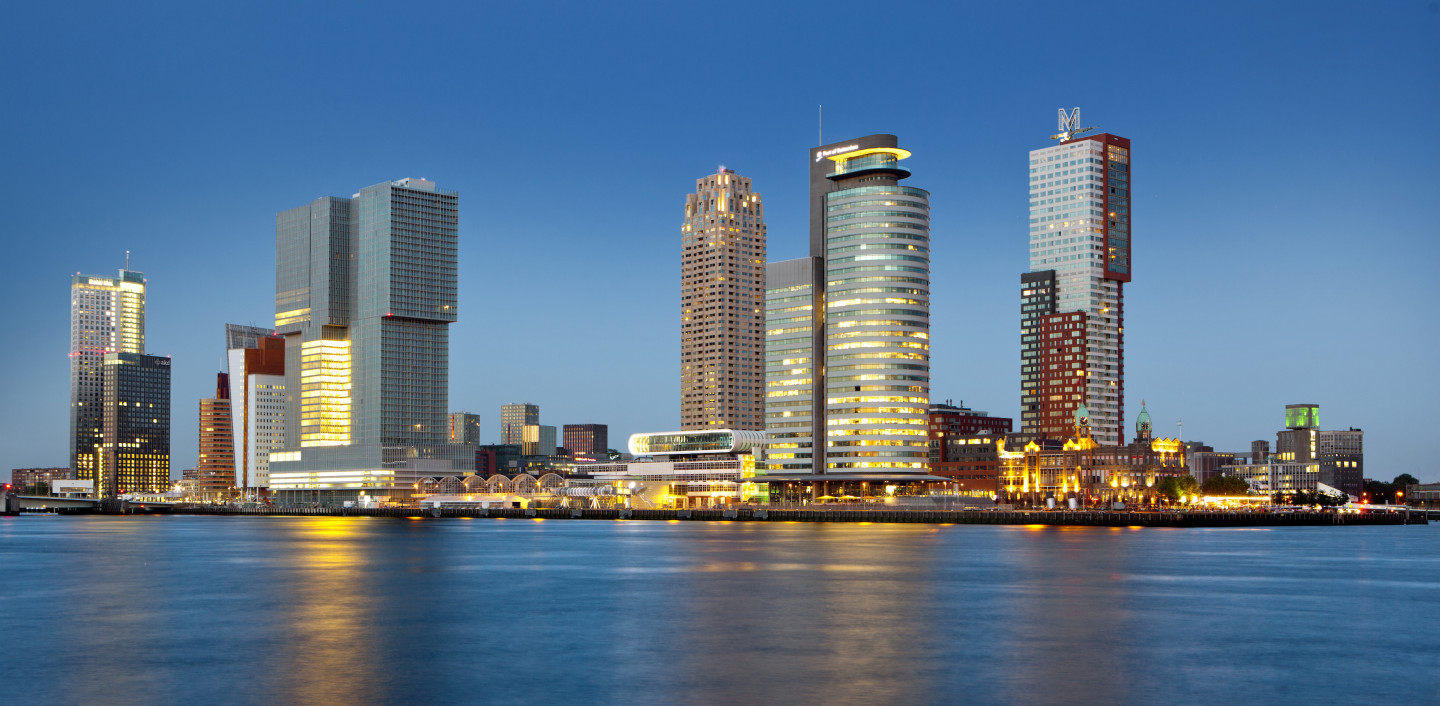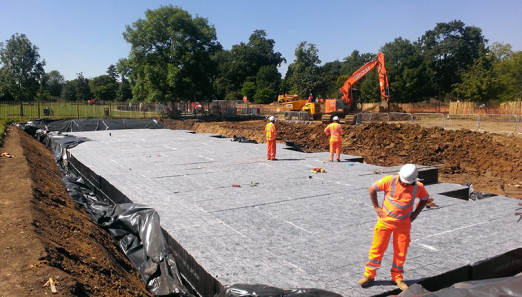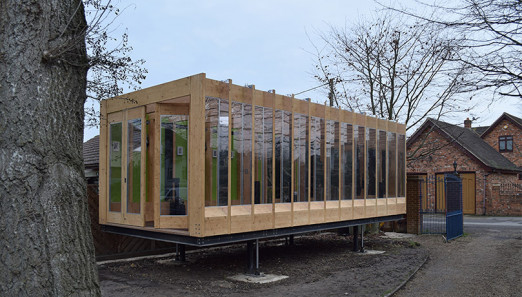Over the next couple of weeks we will be talking to innovators addressing the issue of flooding. Below we talk with Arnoud Molenaar, Chief Resilience Officer of Rotterdam since 2014, a pioneer among what will eventually be 100 Resilience Officers supported by The Rockefeller Foundation. In 2008 he was appointed manager of the Rotterdam Climate Proof programme, developing initiatives to help the city adapt to the reality of climate change for Rotterdam, which he describes as a “port with a city.” Like all innovators, Molenaar is trying to rethink the problem of climate change, redefining it as an opportunity to engage citizens and enable new businesses and technologies to emerge that will help the city, and others, transition to a different relationship with water.
What’s your academic and professional background?
Arnoud Molenaar: I am a Physical Geographer by training, used to working in a multi-disciplinary situation. I’m used to talking with hydrologists, with engineers, with people involved with urban policy. I started as a water advisor at the city, then became deputy head of the water department, and was involved in setting up the first integrated water plan – that was in 2001.
Tell us how you helped foster a change in thinking about water?
Arnoud Molenaar: I also collaborated initiating the vision for Rotterdam Water City 2035 – in 2005, during the architecture biennial in Rotterdam. This vision, created in 2005, just over a decade ago, caused a paradigm shift in the thinking about water.
Before 2005, water, strangely enough, was seen as a problem, costing money and space, and after the project it opened the eyes of politicians, civil servants and colleagues that water is an opportunity. It is a property of the city that you can design with. You can design with water rather than fighting against it.
This vision has been translated into the second water plan in 2007 and in 2008, I added the issue of Climate Change to it when I became the manager of the Rotterdam Climate Proof programme.
What is the role of Chief Resilience Officer?
Arnoud Molenaar: In 2013 we delivered the first Rotterdam Adaptation Strategy, and in 2014 I became the Chief Resilience Officer. As Chief Resilience Officer I am looking at climate resilience but also looking at other related resilience topics, like social resilience, vital infrastructure, cyber, and changing governance which is an important issue. It’s becoming broader.
The role of Chief Resilience Officer is brand new. We became a member of the 100 Resilient Cities of The Rockefeller Foundation. At the end of 2013, the first 33 cities have been selected and in the second wave, London also became a member. The Rockefeller Foundation is helping 100 cities to appoint a Chief Resilience Officer. Worldwide there are now over 50 Chief Resilience Officers, but at the end of this year there will be 100, now they are busy looking at the proposals of the third and last wave. It’s a brand new job!
You are involved then in inventing your role?
Arnoud Molenaar: Yes, you could say as a Chief Resilience Officer I started on my own a year ago, and now over a 100 people within the city are now involved in some way in the Rotterdam Resilience Programme as I called it. I already have some positions as I have been working on Climate Resilience for 10 years.
Could you tell us a little about the conceptual shift you made around living with water? Secondly could you tell us about any physical projects initiated?
Arnoud Molenaar: Regarding the first question, to live with water we mean it should be possible to allow, if possible, some flooding, instead of continually building levees. In Rotterdam, we have levees, but if you just keep on building levees, raising the levees, then within decades you will have giant walls running through the city. Somehow we have to find a way to design the urban landscape in a way that you are not solely dependent on these giant walls, that’s a philosophy. That’s why we started to explore how we can build on water, similar to the boat houses we built on the canals.
In Rotterdam, quite near to the centre, we have a lot of old harbours. They are directly connected to the open sea, there is a high tide and a low tide and the difference is around a metre and a half. That’s why we initiated the floating pavilion just to show that it is possible. A huge hi-tech, lightweight building that generates its own energy and cleaning its own sewerage, just to show that this could be the first step to a floating community in this particular harbour.
Another initiative is about designing with water. The most urgent thing at the moment is to cope with the excessive rainfall. You can do two things – you can put money in larger sewer pipes, which we don’t want to do because that’s not flexible and very expensive and we don’t think that’s sustainable.

(Waterworks at the rooftop park Dakpark)
So it’s better to use your money to redesign the public area and at the same time create more water storage. The best example of this is the water square. We are working on creating a more attractive city to attract more high income people, we are working on a safer city so we can be more attractive for business, but at the same time we are solving this water issue – it’ a holistic approach.
Are there new businesses developing out of this approach responding to this strategy?
Arnoud Molenaar: The most important thing as a city is that we depend on the port – the port is huge. You could say Rotterdam is a port with a city, from the centre to the North Sea it is 50km. What we want to avoid is to keep the Rotterdam port a sound investment for companies. The image now is that we have the safest port in the world. We are looking far ahead, and have developed a sophisticated climate adaptation strategy, we are a safe port and that will remain as it is.
The other thing is because we are relatively well-known for our expertise in this field, a lot of companies and design bureaus are generating business from this. It is why we have recently, as a final element in this whole story, set up the Rotterdam Centre for Resilient Delta Cities.
A lot of design bureaus are getting opportunities to work in Jakarta, Ho Chi Minh City and New York – we’re not only building an attractive city, we are helping economic development.
What is the day-to-day impact of flooding? When was the last big flood?
Arnoud Molenaar: The major flooding in modern times was in 1953, which also affected other parts of Europe. The Big Flood of 1953 cost nearly 2,000 lives, which is why on a national level the delta works started. This gave Rotterdam the famous storm surge barrier, that was the last piece of the puzzle in the national delta programme.

(Maeslantkering strom surge barrier)
We have a second delta program which is looking, like we did at a city level, at designing the scenario (like we did) looking at what will happen at the end of this century, back-casting to actions we need to take now. That is exactly what we did in Rotterdam. We are creating scenarios at city level and national level.
Nowadays you could say, at an average of once a year, we are experiencing small scale flooding along the river, there is a thin layer of water on the embankments.
That’s not really dangerous, but it’s annoying, but if we do nothing, the frequency and depth of this will increase over time. The other thing is that we are experiencing small-scale flooding because of excessive rainfall but that’s in the urban area itself – that’s why we are restoring what you might call the ‘sponge’ function of the city. So for example over the last five years we have developed over 220 square metres of green roofs.

(The Benthemplein water square)
We have developed three water squares and an underground basin in combination with a parking garage. And an urban flood plain, we have a canal that in extreme circumstances is allowed to overflow a terrace with statues. That’s a combination of design of public space and water storage.
That’s all public money? Or a mix of public and private?
Arnoud Molenaar: So far it is mainly public money. Nowadays the role of local government is changing and there is less budget, so we are looking to involve citizens. It’s not only a matter of big projects such as water squares or levees; if you want to be a climate-proof city as a whole, you want large-scale and small-scale solutions.

(First presentation of permeable pavement in ZoHo, September 2015)
The green roof is an example but also de-paving streets and gardens, and introducing rain gardens. It is important to combine this with the greening ambitions of your city.
Public engagement is a crucial part of what you do, you have to engage citizens?
Arnoud Molenaar: The interesting thing is that we noticed that after we designed the water square, people came with their own ideas, so the district of the water square is now the pilot district to become the first climate adaptive district in the city. There are so many initiatives locally and our role is just to facilitate this process. We want to upscale this experience to other districts, to climate proof the whole city.


